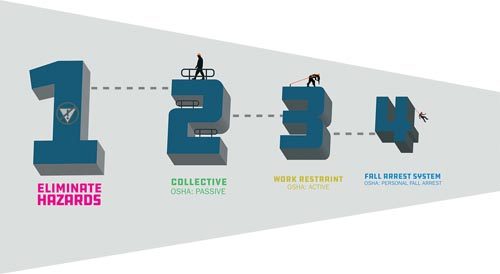Fall restraint vs. fall arrest
What’s the difference between fall restraint and fall arrest, and why is it important?

Responding is Brian Stickler, strategic business development manager, Kee Safety Inc., Buffalo, NY.
Answer: The answer comes from an understanding of the “hierarchy of fall protection” – a four-step analytical process of rooftop safety. Fall restraint and fall arrest are the final two components on that list.
The first consideration is to eliminate the hazard altogether if possible. Is there an alternative way to perform the job without getting on the roof, such as working from the ground or on a lift? If not, and it’s determined that the roof needs to be accessed for maintenance, repair, inspection or another task, then the most appropriate form of fall protection needs to be selected.
The second step in the hierarchy is collective fall protection, which is considered “passive” by OSHA. Guardrails are an ideal form of such protection because they can collectively safeguard multiple employees at the same time. There’s also little training associated with installed railings.
A guardrail may not be considered first because the upfront cost is usually more than other forms of fall protection. Although, ideally, cost shouldn’t be the deciding factor to keep workers safe, and some situations may not warrant a guardrail. This can be because of space limitations on the roof or the task can be performed relatively quickly.
If a guardrail isn’t suitable, then personal fall protection will be necessary. This means the worker is responsible for their safety through proper use and inspections of their personal protective equipment. In the hierarchy, both fall restraint and fall arrest are forms of personal fall protection. Items such as harnesses, lanyards and anchorage systems are PPE that need to be inspected before and during each use.
Fall restraint comes third in the hierarchy for good reason. Fall restraint allows workers to be at height but restrains them from access to the roof edge or another fall hazard by using PPE. A fixed-length lanyard is the safest such option. Think of a dog tied to a leash or rope that prevents it from reaching the sidewalk.
Fall arrest, the final step in the hierarchy, allows the worker to access the roof or hazard. In the event of a fall, it will keep the worker from hitting the ground or objects below. Fall arrest is necessary when it’s not possible to avoid working near an edge. It’s designed to save the worker’s life, although injuries may result from a fall.
Knowing the difference between fall restraint and fall arrest in the hierarchy of fall protection will help prepare safety managers and other company leaders to work with professional fall protection specialists. They can then determine the most appropriate solutions for working at height to separate people from hazards.
Editor's note: This article represents the independent views of the author and should not be construed as a National Safety Council endorsement.
Post a comment to this article
Safety+Health welcomes comments that promote respectful dialogue. Please stay on topic. Comments that contain personal attacks, profanity or abusive language – or those aggressively promoting products or services – will be removed. We reserve the right to determine which comments violate our comment policy. (Anonymous comments are welcome; merely skip the “name” field in the comment box. An email address is required but will not be included with your comment.)

